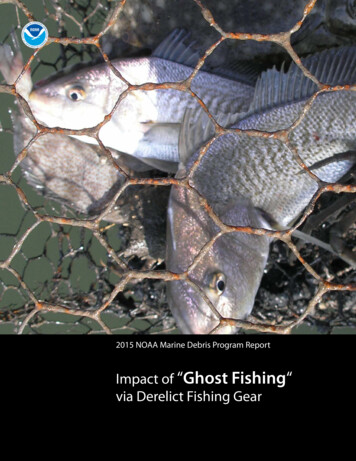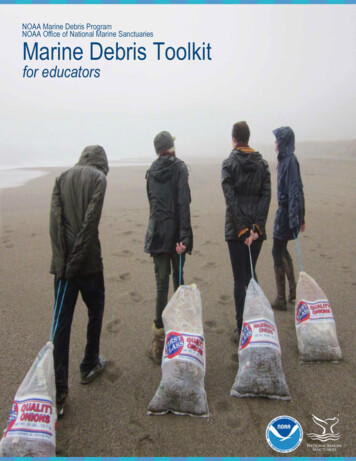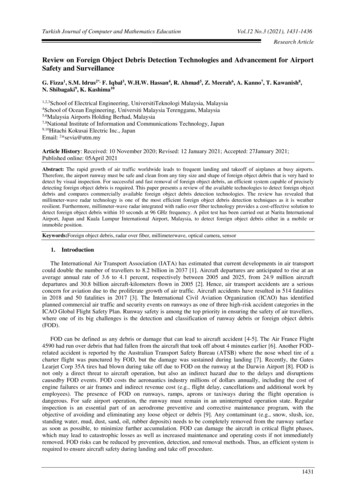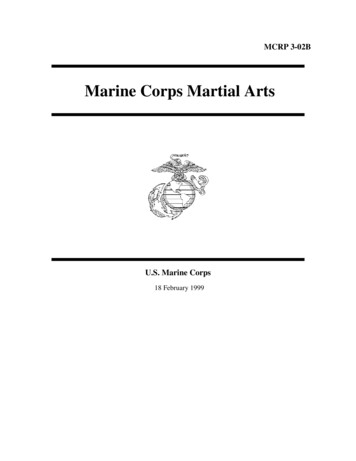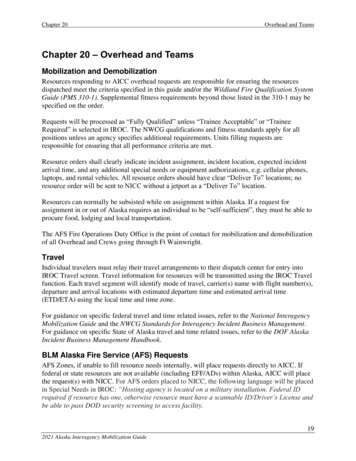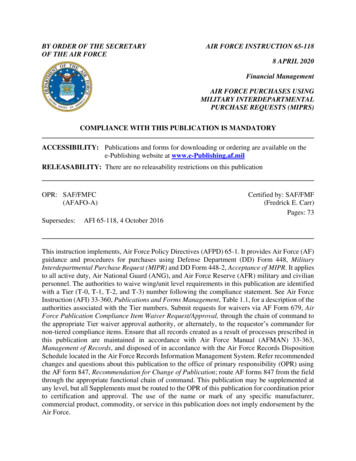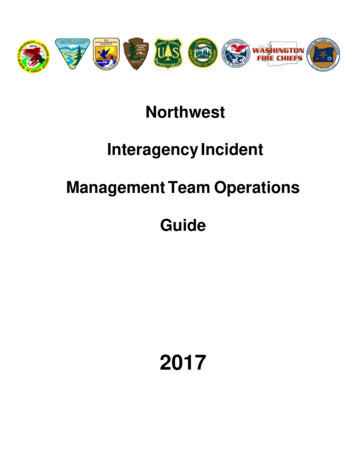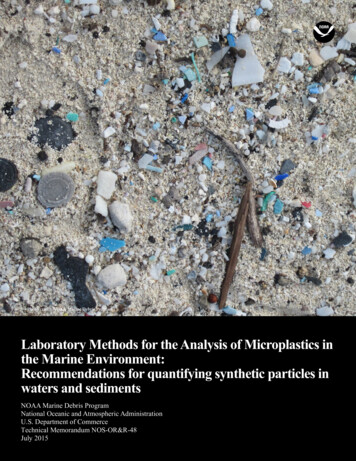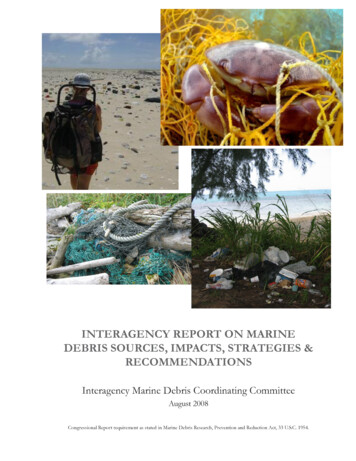
Transcription
INTERAGENCY REPORT ON MARINEDEBRIS SOURCES, IMPACTS, STRATEGIES &RECOMMENDATIONSInteragency Marine Debris Coordinating CommitteeAugust 2008Congressional Report requirement as stated in Marine Debris Research, Prevention and Reduction Act, 33 U.S.C. 1954.
This Congressional Report was developed by the Interagency Marine Debris Coordinating Committee and produced by theNational Oceanic and Atmospheric Administration (NOAA), U.S. Department of Commerce to fulfill requirements of theMarine Debris Research, Prevention and Reduction Act, 33 U.S.C. 1954.August 2008For citation purposes, please use:For information or copies, please contact:National Oceanic and Atmospheric Administration. 2008NOAA Marine Debris ProgramInteragency Report on Marine Debris Sources, Impacts,Office of Response and RestorationStrategies & Recommendations. Silver Spring, MD. 62 ppNational Ocean Service1305 East West HighwaySilver Spring, MD 20910301-713-2989www.marinedebris.noaa.gov
INTERAGENCY REPORT ON MARINEDEBRIS SOURCES, IMPACTS, STRATEGIES& RECOMMENDATIONSInteragency Marine Debris Coordinating Committee2008
INTERAGENCY REPORT ON MARINE DEBRIS SOURCES, IMPACTS, STRATEGIES & RECOMMENDATIONS4Report of theINTERAGENCY MARINE DEBRIS COORDINATING COMMITTEECo-Chair, Department of Commerce, National Oceanic and Atmospheric AdministrationCo-Chair, Environmental Protection AgencyDepartment of Defense, NavyDepartment of Homeland Security, Coast GuardDepartment of the Interior, Fish and Wildlife ServiceDepartment of the Interior, Minerals Management ServiceDepartment of Justice, Environment and Natural Resources DivisionDepartment of State, Office of Marine ConservationMarine Mammal CommissionUnited States Army Corps of EngineersCoastal America (Ex Officio)
5COMMITTEE MEMBERSHolly Bamford, Ph.D.IMDCC Co-ChairDepartment of CommerceNational Oceanic and Atmospheric AdministrationNational Ocean ServiceMolly MaddenIMDCC Co-ChairEnvironmental Protection AgencyOffice of WaterOceans and Coastal Protection DivisionSarah MorisonDepartment of CommerceNational Oceanic and Atmospheric AdministrationMike PletkeDepartment of DefenseNavyDavid MajorDepartment of Homeland SecurityCoast GuardMary Sohlberg (Alternate)Department of Homeland SecurityCoast GuardAndrew GudeDepartment of the InteriorFish and Wildlife ServiceRichard ClinganDepartment of the InteriorMinerals Management ServiceHolly KoehlerDepartment of StateOffice of Marine ConservationBradford McLaneDepartment of JusticeEnvironment and Natural Resources DivisionMary Boatman (Alternate)Department of the InteriorMinerals Management ServiceKatherine WeilerEnvironmental Protection AgencyOffice of WaterMike SimpkinsMarine Mammal CommissionPatricia MutschlerUnited States Army Corps of EngineersMegan ForbesIMDCC Executive SecretaryDepartment of CommerceNational Oceanic and AtmosphericAdministrationWilliam NuckolsCoastal America, Ex OfficioINTERAGENCY REPORT ON MARINE DEBRIS
INTERAGENCY REPORT ON MARINE DEBRIS SOURCES, IMPACTS, STRATEGIES & RECOMMENDATIONS6AcknowledgementsThe Interagency Marine Debris Coordinating Committee would like to acknowledge the many people inaddition to the IMDCC Committee members who provided outstanding input, support, editing, and reviewof this report throughout the entire process. We would first like to recognize Neal Parry, Interagency ReportCoordinator, for his outstanding efforts in researching, drafting, and organizing the report, as well as workingwith and consolidating the many agency comments throughout this process. His role in the development andcompletion of this report was invaluable. We would also like to thank the many others who were involved inthe development of the report, including Liz Shaner, David Redford, Leonard Pace, Libby Etrie, CourtneyArthur, and Bret Wolfe. A thank you also goes to editors Mary Swift and Kris McElwee for their review ofthe final drafts of the document and Carey Morishige for her assistance in document layout.We would also like to acknowledge the IMDCC executive committee, the Subcommittee on IntegratedManagement of Ocean Resources, for their review and approval of this document and the Joint Subcommitteeon Ocean Science and Technology for their review. Finally, we would like to recognize the InteragencyCommittee on Ocean Science and Resource Management Integration members for their final review andapproval of the report before final submission to the Office of Management and Budget and Congress.
7List of TablesPageTable 1Significant sources of marine debris . 18Table 2Federal authorities by agency that(1) specifically mention marine debris in the authority,(2) address sources and items that could become marine debris (e.g., plastic,fishing gear, garbage), and(3) address entities that may be impacted by marine debris.An “X” in the last column represents legislation that has any regulatorycomponent. Appendix I includes detailed information on theseauthorities. 30INTERAGENCY REPORT ON MARINE DEBRIS
INTERAGENCY REPORT ON MARINE DEBRIS SOURCES, IMPACTS, STRATEGIES & RECOMMENDATIONS8List of AcronymsAPPSAct to Prevent Pollution from ShipsIMOInternational Maritime OrganizationBHABoston Harbor AssociationIOCIntergovernmental OceanographicCommissionCSOCZMACombined Sewer OverflowIRTInnovative Readiness TrainingJSOSTJoint Subcommittee on OceanCoastal Zone Management ActDOJU.S. Department of JusticeENRDEnvironment and Natural ResourcesScience and TechnologyMARPOLInternational Convention forPrevention of Pollution from ShipsMPPRCAMarine Plastics Pollution Researchand Control ActMDRPRAMarine Debris Research,DivisionEPAU.S. Environmental ProtectionAgencyPrevention, and Reduction ActESAEndangered Species ActEUEuropean UnionMMCMarine Mammal CommissionFWSU.S. Fish and Wildlife ServiceMMSMinerals Management ServiceICCInternational Coastal CleanupNASNational Academy of SciencesIMDCCInteragency Marine DebrisNMDMPNational Marine DebrisMonitoring ProgramCoordinating Committee
9NOAANational Oceanic and AtmosphericAdministrationNPSNational Park ServiceNSCNorthwest Straits CommissionNWHINorthwestern Hawaiian IslandsOCSOuter Continental ShelfPSAPublic Service AnnouncementRCRAResource Conservation andRINARegistro Italiano Navale GroupSCATShoreline Cleanup and AssessmentTechniqueUNEPUnited Nations EnvironmentProgrammeUNESCOUnited Nations Educational,Scientific, and Cultural OrganizationUSACEU.S. Army Corps of EngineersUSCGU.S. Coast GuardINTERAGENCY REPORT ON MARINE DEBRIS
INTERAGENCY REPORT ON MARINE DEBRIS SOURCES, IMPACTS, STRATEGIES & RECOMMENDATIONS10
11Table of 8Executive Summary .Introduction .Overview .History of Federal Marine Debris Coordination .Interagency Marine Debris Coordinating Committee.Charge to the IMDCC.Sources of Marine Debris.Land-based Sources .Ocean-based Sources.Ecological, Human, and Economic Impacts .Ecological Impacts.Human Impacts .Economic Impacts .Current Actions .Education and Outreach .Legislation / Regulation / Policy.Incentive Programs .Enforcement .Cleanups.Research .Technology Development.Fostering Coordination .Recommendations.Education & Outreach .Legislation / Regulation / Policy.Incentive Programs .Enforcement .Cleanups.Research .Technology Development.Fostering Coordination 6464747474848APPENDIX I : Detailed Description of Authorities as Related to Marine Debris.Literature Cited.Photography Credits and Captions.495963INTERAGENCY REPORT ON MARINE DEBRIS
INTERAGENCY REPORT ON MARINE DEBRIS SOURCES, IMPACTS, STRATEGIES & RECOMMENDATIONS12Section 1.0 Executive SummaryFor the purposes of this document, the Interagency Marine Debris Coordinating Committee (IMDCC)considered persistent solid man-made debris from both land-based and ocean-based sources and its adverseimpacts on the marine environment and navigation safety.1Marine debris can degrade ocean habitats, endanger marine and coastal wildlife, interfere with navigation,esult in economic losses, and threaten human health and safety. Sources of marine debris are wide ranging.Marine debris can originate from ocean-based sources, such as a ship that loses its cargo, and land-basedsources, such as material that runs off of the landscape into rivers and oceans. The nature, type, and impacts,however, are similar regardless of where the debris originates. Research indicates a broad range of ecological,human health and safety, and economic impacts.There are many challenges to addressing the issue of marine debris. The vast number of possible sources bothon land and at sea, as well as the potential for debris to travel far from its origin and persist in the ocean foryears complicates prevention efforts. Successful prevention also depends on changing attitudes and behaviorwhich can be difficult if the public and relevant stakeholders do not understand the links between their actionsand marine debris. Despite existing regional and species specific studies, gaps in knowledge remain and limita complete characterization of the marine debris issue and its ecological, human, and economic impacts.1The United States Coast Guard (USCG) and National Oceanic and Atmospheric Administration (NOAA) have been tasked throughthe Marine Debris Research, Prevention, and Reduction Act (33 U.S.C. 1954) with jointly developing, in consultation with the IMDCC, a defini tion of marine debris for the purposes of the aforementioned Act. USCG and NOAA have not finalized a definition of marine debris as of thecompletion of this document in June 2008. Any description of marine debris in this document is intended only to assist readers of this docu ment to better understand the issue of marine debris. It is not intended that any description of marine debris in this document be proposed as alegal definition.
13Existing legislation, policies, and regulations address marine debris both directly and indirectly; however, thenumber of agencies and mixture of federal, state, and local authorities requires extensive coordination to beeffective.In recognition of the complexity of the marine debris issue, the IMDCC was reconvened as recommended bythe Administration’s 2004 Ocean Action Plan. The IMDCC was formally established by statute through theMarine Debris Research, Prevention, and Reduction Act in order to coordinate a comprehensive program ofmarine debris research and activities among federal agencies. The IMDCC is charged to submit to Congressa report that identifies: sources of marine debris; the ecological and economic impact of marine debris;alternatives for reducing, mitigating, preventing, and controlling the harmful affects of marine debris; thesocial and economic costs and benefits of such alternatives; and recommendations to reduce marine debrisboth domestically and internationally.This report fulfills the charge given to the IMDCC. The report describes sources and impacts of marinedebris, as well as the challenges associated with their characterization. Also discussed are the alternatives,or current activities, to address marine debris that have occurred over the past 20 years, including activitiesrecommended in the report of the 1988 Interagency Task Force on Persistent Marine Debris. Finally, thisreport contains 25 recommendations intended to guide the Federal government’s strategies on marine debris(See Section 6, “Recommendations,” on page 45).The recommendations presented in this report are designed to be broad in scope, with the intention thatfederal agencies work collaboratively through the IMDCC to develop more detailed priorities and action plansto implement these recommendations. In addition to having a federal-level focus, these recommendationsalso attempt to address the different agency mandates and policies associated with issues related to marinedebris reduction and prevention. While the recommendations are general in nature, individual agencies areexpected to lead coordinated efforts and work together to enhance and develop existing capacities so thatindividual agency efforts can work to address collective needs, threats, and challenges. Federal agencies arefurther encouraged to enhance their efforts to provide technical and educational materials to state, local, tribaland non-governmental entities.A comprehensive approach to the issue of marine debris is organized around four main themes:(1) prevention; (2) response to debris already in environment; (3) research and development; and (4) crosstheme (i.e., coordination). The IMDCC’s recommendations are organized by the following subsets of thesethemes:1.Marine debris prevention through education and outreach, legislation/regulation/policy, and incentiveprograms.2.Response to debris already in the environment through enforcement and cleanups.3.Research and technology development to assess next steps, address gaps, reduce or prevent materialfrom entering marine system, and mitigate impacts.4.Cross-theme efforts that foster coordination among federal agencies and other government andnon-governmental partners to share information, coordinate efforts, and implement actions to prevent,reduce, or mitigate impacts of marine debris.The IMDCC and its member agencies are committed to a collaborative approach to marine debris and tothe implementation of these recommendations. The IMDCC intends to develop an action plan for theimplementation of these recommendations. The IMDCC will report on progress with these recommendationsas part of the IMDCC’s regular progress report to Congress.INTERAGENCY REPORT ON MARINE DEBRIS
INTERAGENCY REPORT ON MARINE DEBRIS SOURCES, IMPACTS, STRATEGIES & RECOMMENDATIONS14Section 2.0 Introduction2.1 Overview of IssueMarine debris can injure and kill marine wildlife, degrade ocean habitats, interfere with navigation safety,cause economic loss to shipping, fishing, and coastal communities, and pose a threat to human health. Theseadverse impacts have been documented all over the world. From fishing nets to medical equipment to foodpackaging, many man-made persistent objects play key roles in supporting the economy and protecting humanhealth. However, when these same objects are abandoned or even disposed of improperly, they may enter themarine environment and become marine debris. As consumption and use of these objects increases globally,the challenge of containing and properly managing them becomes even greater, regardless of whether thesematerials enter the marine environment directly from activities on the water or indirectly from activities onland.The problem of marine debris can be dealt with effectively only by ensuring a comprehensive approach thatis local in scale and global in scope, directed at source prevention, and establishes an educated communitythat can be empowered to action. While it is important to address marine debris already present in theenvironment, such as through beach cleanups or preventing entanglements of marine wildlife, this is not theonly type of strategy and action that should be taken. An effective response must be comprehensive andinclude research, prevention, and reduction. Ultimately, any successful solution requires a mobilization ofpublic and stakeholder actions resulting in a change in attitudes and practices that will prevent marine debrisat its many sources. Developing such public concern and behavior change requires educating the public andspecific audiences about the causes, impacts, and both the global scope and local relevance of marine debris, aswell as providing the tools necessary to reduce and prevent debris at its source. In this report, the InteragencyMarine Debris Coordinating Committee recommends a comprehensive strategy to address marine debris thatrelies on a coordinated approach among existing and new partners to support actions at many levels. Thisstrategy is an integral step towards solving the marine debris problem.
152.2 History of Federal Marine DebrisCoordinationprograms that engaged volunteer groups to helpmonitor, report, cleanup, and prevent ocean andshoreline plastic pollution.Since the early 1970s, numerous federal programshave been created to address various aspectsof the marine debris problem. However, theseprograms have been scattered among agenciesthat have markedly different mandates andauthorities.Since the release of the 1988 Task Force Report,federal agencies have implemented some of thereport’s recommendations for additional research,monitoring, and removal, as well as to fosterstewardship of the oceans.Coordinationamongthesenumerous programs has alwaysbeen challenging.It was not until the mid-1980s that the Federalgovernment attempted to address the marinedebris problem holistically. Events such as theextensive marine debris wash-ups along New Jerseyand New York beaches in 1976 and 1987 spurredthe Administration and Congressional leaders in1987 to recognize the need to assess the problemscaused by persistent marine debris. The White House Domestic Policy Councilformed an “Interagency Task Force on PersistentMarine Debris” in 1987 to develop a reportthat assessed the need for research, reductionmeasures, and alternative actions to addressthe problem of plastic marine pollution. Thatreport was completed in 1988 and included23 recommendations focused on federalleadership, education programs, regulations,research, beach cleanups, and monitoring. In 1987, the Marine Plastics PollutionResearch and Control Act (MPPRCA) waspassed to amend the Act to Prevent Pollutionfrom Ships (APPS), which implements theInternational Convention for the Preventionof Pollution from Ships (MARPOL) Annex V. MARPOL Annex V sets forth regulationsfor the prevention of pollution by garbage fromships, and among other things, prohibits dischargeof all plastics by ships into the sea. In addition,the MPPRCA authorized the U.S. EnvironmentalProtection Agency (EPA), the National Oceanicand Atmospheric Administration (NOAA),and the U.S. Coast Guard (USCG) to conduct The EPA created its Marine Debris Program,which supports projects to investigate and addresssources and transport of marine debris, such as aplastic pellet containment study. The EPA alsoinitiated the Combined Sewer Overflows StudiesProgram, the Harbor Studies Program, theStorm Drain Sentries Program, and the NationalMarine Debris Monitoring Program, which wasadministered by Ocean Conservancy through agrant from EPA to determine marine debris statusand trends on beaches in the United States. NOAA created the Marine EntanglementResearch Program to support projects evaluatingadverse impacts of persistent marine debris onthe marine environment, as well as to developeducational materials for local coastal communities.NOAA also organized four international marinedebris conferences between 1984 and 2000 andled the interagency derelict net cleanup fromthe Northwestern Hawaiian Islands starting in1996. USCG prepared regulations to implementMARPOL Annex V in 1989. Many other federal agencies establishedmarine debris reduction and educational activitiesand projects to help address the marine debrisproblem. Although individual agencies createdand continued programs to address marine debris,the Task Force did not maintain formal ongoingcoordinating meetings.However, informalinteragency workgroups did meet periodically todiscuss domestic and international activities formarine debris.INTERAGENCY REPORT ON MARINE DEBRIS
16INTERAGENCY REPORT ON MARINE DEBRIS SOURCES, IMPACTS, STRATEGIES & RECOMMENDATIONS2.3 Interagency Marine DebrisCoordinating CommitteeIn 2004, the topic of marine debris came tothe forefront again with the release of the U.S.Commission on Ocean Policy Report: An OceanBlueprint for the 21st Century. An entire chapter wasdedicated to discussing the impacts of marinedebris on the environment.The Commission recommended that the Federalgovernment take action to address the problemby recreating an interagency committee to uniteall appropriate federal agencies on this issue.In response to the Report, the Administrationreleased the 2004 Ocean Action Plan andreestablished the Task Force, which was renamedthe Interagency Marine Debris CoordinatingCommittee (IMDCC). The IMDCC’s mandatewas soon codified with the passage of the MarineDebris Research, Prevention, and Reduction Actof 2006 (Act), which amended the Coordinationsection of the MPPRCA. The role of the IMDCC is to consider andaddress any abandoned or uncontrolled solidmaterial that is introduced into the oceanand coastal environment or the Great Lakesand poses a potential adverse impact to theenvironment, human health, safety, economy, orother resources. The objective of the IMDCC is to coordinatea comprehensive program of marine debrisresearch, prevention, reduction and removalactivities among federal agencies, in cooperationand coordination with non-governmentalorganizations, industries, universities, researchinstitutions, states, tribal governments, and othernations, as appropriate. The Act also established a reporting requirementfor the IMDCC that includes submitting thisreport to Congress on marine debris impactsand strategies, followed by progress reports toCongress every two years on the implementationstatus of the strategies and recommendationspresented herein.2.4 Charge to the IMDCCThe IMDCC was charged by theAct to address in this report:(i) the sources of marine debris;(ii) the ecological and economic impact ofmarine debris;(iii) alternatives for reducing, mitigating,preventing, and controlling theharmful effects of marine debris;(iv) the social and economic costs and benefitsof such alternatives; and(v) recommendations to reduce marine debrisboth domestically and internationally.In response to the first (i) and second (ii) charges,the IMDCC reviewed a number of recentlypublished studies of sources of marine debrisand impacts of marine debris on organisms,ecosystems, and the economy. The IMDCC also discussed how changesin society and the use of so-called disposablematerials can affect the amount of marine debrisproduced by various sources. For example, recentincreases in the use of persistent synthetic materialssuch as plastics demonstrate the importance ofmonitoring and controlling the full “life cycle” ofthese products, including production, distribution,use, disposal, and handling of the materialsthroughout all phases. In many ways, marine debris sources are asocietal problem that often reflects a lack ofknowledge regarding the impacts of marine debrisand appropriate disposal practices, a general lackof interest in following the appropriate practices,or an inability to follow appropriate practices ifinfrastructure is missing or costs are too high.Both lack of knowledge and lack of interest canbe addressed by ensuring that all members ofour society are educated regarding the correctpractices as well as the potential impacts ofinappropriate disposal.The IMDCC reviewed existing programs andprojects currently being conducted by or in partby the Federal government with partners
17to determine alternatives for addressing marinedebris (iii) and the benefits of such alternatives(iv). The IMDCC recognized that a clearexplanation of the economic costs and benefitsof current alternatives to reduce, prevent, andremove marine debris from our environmentis still lacking. This type of analysis is difficultto conduct and requires cost-benefit data notcurrently available.(2) response to debris already in the environmentthrough enforcement and cleanups; Types of data that would be needed includeoverall socio-economic impact, the value ofresources being impacted, the cost of removaltechnologies and restoration requirements, and thetotal amount of marine debris in the environment.Also missing is an understanding of the location,source, and impacts of submerged debris.These recommendations can be best implementedthrough a focus on sustained, collaborativeefforts in which agencies work in conjunctionwith each other and with non-federal entities toaddress common goals. The IMDCC intends todevelop an action plan that will prioritize andtrack implementation of these recommendationstoensure a coordinated effort toward a cleaner,debris-free environment. A number of efforts have been conductedfor beach and shoreline monitoring. However,limited research has been completed to determinehow the presence of debris on the seafloorimpacts submerged habitats, corals, seagrass, fishmigration, and other living marine resources.Likewise, few data exist to quantify the amounts,types, and impacts of debris on the surface and inthe water column in the open ocean.(3) research and technology development toassess next steps, address gaps, reduce or preventmaterial from entering the marine system, andmitigate impacts; and(4) cross-theme efforts that foster coordination Gaps in marine debris research, monitoring,costs, and benefits need to be filled in order toconduct a proper cost and benefit analysis.Overall, the recommendations (v) laid out in thereport are general in nature to encompass thebreadth and responsibilities of each agency anddepartment dealing with the marine debris issue.Many recommendations also seek to fill the gapsand data need identified in other parts of thisreport.Recommendations are focusedaround four themes encompassingseveral topic areas:(1) marine debris prevention through educationand outreach, legislation/regulation/policy, andincentive programs;INTERAGENCY REPORT ON MARINE DEBRIS
INTERAGENCY REPORT ON MARINE DEBRIS SOURCES, IMPACTS, STRATEGIES & RECOMMENDATIONS18Section 3.0 Sources of Marine DebrisPeople and their actions, whether intentional or accidental, are the source of most marine debris. For thisreason, it is important to identify and target the specific locations or types of activities that gener
the Marine Debris Research, Prevention, and Reduction Act (33 U.S.C. 1954) with jointly developing, in consultation with the IMDCC, a deini tion of marine debris for the purposes of the aforementioned Act. USCG and NOAA have not inalized a deinition of marine debris as of the completion of this document in June 2008.

